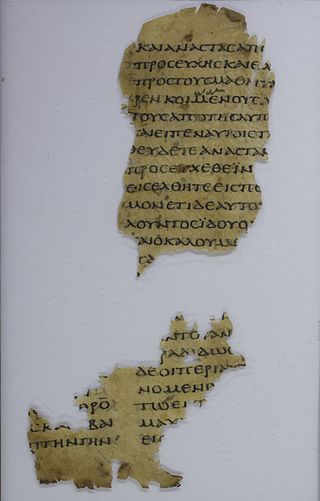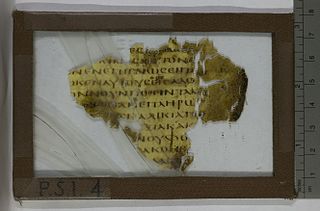Related Research Articles

Uncial 0171, ε 07 (Soden) are two vellum leaves of a late third century Greek uncial Bible codex containing fragments of the Gospel of Matthew and the Gospel of Luke. Luke fragment, in two parts, is preserved in the Laurentian Library collection in Florence, and the Matthew fragment is in the Berlin State Museum.

Codex Vaticanus, designated by S or 028, ε 1027, formerly called Codex Guelpherbytanus, is a Greek manuscript of the four Gospels which can be dated to a specific year instead of an estimated range. The colophon of the codex lists the date as 949. This manuscript is one of the four oldest New Testament manuscripts dated in this manner, and the only dated uncial.
Uncial 082 α 1024 (Soden), is a Greek uncial manuscript of the New Testament, assigned palaeographically to the 6th century.

Papyrus 36, designated by siglum 𝔓36, is a copy of the New Testament in Greek. It is a papyrus manuscript of the Gospel of John, it contains only John 3:14-18.31-32.34-35. The manuscript palaeographically has been assigned to the 6th century.

Papyrus 48 (Gregory-Aland), signed by 𝔓48, is an early copy of a part of the New Testament in Greek. It is a papyrus manuscript of the Acts of the Apostles, it contains portions of Acts 23:11-29. The manuscript paleographically has been assigned to the 3rd century.
Uncial 0159, α 1040, is a Greek uncial manuscript of the New Testament, dated palaeographically to the 6th century.

Uncial 0172, is a Greek uncial manuscript of the New Testament, dated palaeographically to the 5th century.

Uncial 0173, is a Greek uncial manuscript of the New Testament, dated paleographically to the 5th century.
Uncial 0174, is a Greek uncial manuscript of the New Testament, dated paleographically to the 5th century.

Uncial 0175, is a Greek uncial manuscript of the New Testament, dated palaeographically to the 5th century The manuscript has survived in a very fragmentary condition.

Uncial 0176, is a Greek uncial manuscript of the New Testament, dated paleographically to the 4th century.

Uncial 0207, is a Greek uncial manuscript of the New Testament, dated paleographically to the 4th-century.
Uncial 0211, ε 051 (Soden), is a Greek uncial manuscript of the New Testament, dated paleographically to the 7th century.
Uncial 0229, is a Greek uncial manuscript of the New Testament. The manuscript paleographically has been assigned to the 8th century. It is a palimpsest.
Uncial 0233, is a Greek uncial manuscript of the New Testament. The manuscript paleographically had been assigned to the 8th-century.
Uncial 0241, is a Greek uncial manuscript of the New Testament. Paleographically it has been assigned to the 6th century.

Uncial 0244, is a Greek uncial manuscript of the New Testament. Paleographically it has been assigned to the fifth century.
Papyrus 126, designated by siglum 𝔓126, is a copy of the New Testament in Greek. It is a papyrus manuscript of the Epistle to the Hebrews.
Uncial 0320, is a diglot Greek-Latin uncial manuscript of the New Testament on parchment. Palaeographically it has been assigned to the 10th-century. Formerly it was designated by Dabs2. The manuscript is very lacunose.
References
- 1 2 3 4 5 Aland, Kurt; Aland, Barbara (1995). The Text of the New Testament: An Introduction to the Critical Editions and to the Theory and Practice of Modern Textual Criticism. Erroll F. Rhodes (trans.). Grand Rapids: William B. Eerdmans Publishing Company. p. 126. ISBN 978-0-8028-4098-1.
- 1 2 3 "Liste Handschriften". Münster: Institute for New Testament Textual Research. Retrieved 18 December 2015.
- ↑ Ernest Best, Robert McLachlan Wilson, Text and interpretation: Studies in the New Testament, Cambridge University Press, 1979, p. 89.
- 1 2 3 Nils Alstrup Dahl, 0230 (= PSI 2306) and the Fourth-century Greek - Latin Edition of the Letters of Paul, in: Text and Interpretation (ed. E. Best and R. McL. Wilson) (Cambridge, 1979), p. 79.
- ↑ Giovanni Mercati, Pubblicazioni della Società Italiana XIII (1953), pp. 87–102.
- ↑ Kurt Aland (1963). Kurzgefasste Liste der griechieschen Handschriften des Neuen Testaments. Berlin: Walter de Gruyter. p. 10.